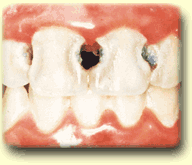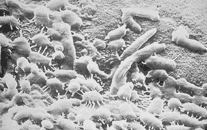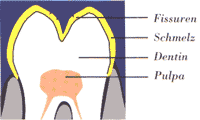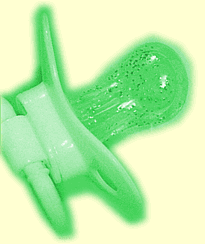Caries
What is caries?
Although caries is a common dental disease - no one is born with caries and it is not heritable. Caries is a disease that slowly destroys the hard tooth substance, the enamel, the dentin or the cementum. It is a process in which bacteria work into the tooth. First, the hard enamel is ruined, then the softer dentin layer. Now the tooth might start to hurt sometimes. Especially when eating sweet or cold foods, the nerve fibres that are in the tooth interior (in the dental pulp) react with pain. This can spread beyond the tooth to the infected side of the jaw. Finally, in the advanced stage of the caries the tooth rots under intense discomfort. If a tooth is seized by caries, it cannot be cured by any medication. The dentist has to remove decayed parts of the hard tooth substance with instruments, e.g. a drill. As the removed tooth parts will not regrow, the occurred defect must be covered with a suitable filling material or a crown.

Caries in the initial stage
Small brown spots on the tooth
How does caries develop?
The outer layer of the tooth, the enamel, consists of a variety of minerals. They harden the enamel and ensure that we can grind hard pieces of food with our teeth. Further, the enamel protects the tooth against thermal and chemical influences, e.g. hot coffee or ice cream. Individual minerals of the outer enamel layer, e.g. the calcium, can be slowly dissolved out by acids. This is called decalcification.

Decayed caries
Caries in focus
It is natural for bacterial colonies to accumulate on various parts of the tooth. These can become active through the frequent intake of sugar in food. These colonies, the so-called streptococci, multiply especially in the deep dips and fissures of the chewing surfaces and near the gum. They attach themselves to the enamel surface and form an increasingly thickening bacterial area: the plaque. Some types of bacteria (e.g. the streptococci) in this plaque system convert carbohydrate-containing food particles (sugar) into acid via a metabolism. The enamel is now attacked by the acid, leading to a defect formation in the hard tooth substance. In the further course, this decalcification continues in the width and depth of the enamel and the underlying dentin layer.
All children are born without caries germs, usually it is the mothers or other caregivers, e.g. by licking the pacifier your own tooth decay bacteria transferred to the oral cavity of the child.

Streptococci (germs that can be transmitted,
for example, from mother to child)
Please note:
Do not lick the pacifier
Do not lick the spoon
No sweetened teas in pacifier bottles
Do not let babies use baby bottles as pacifiers
Choose sweets with sugar substitutes
Fluoride intake in consultation with the dentist
Visit the dentist with the children starting age as early as 6 months

What is the plaque?
The plaque is a soft, variable thick layer compound of bacteria, their products and salivary components. It forms particularly strong in the fissures and on the teeth ridge. Not to be confused with tartar: tartar is calcified plaque. The dentist can make the plaque build-up visible.













